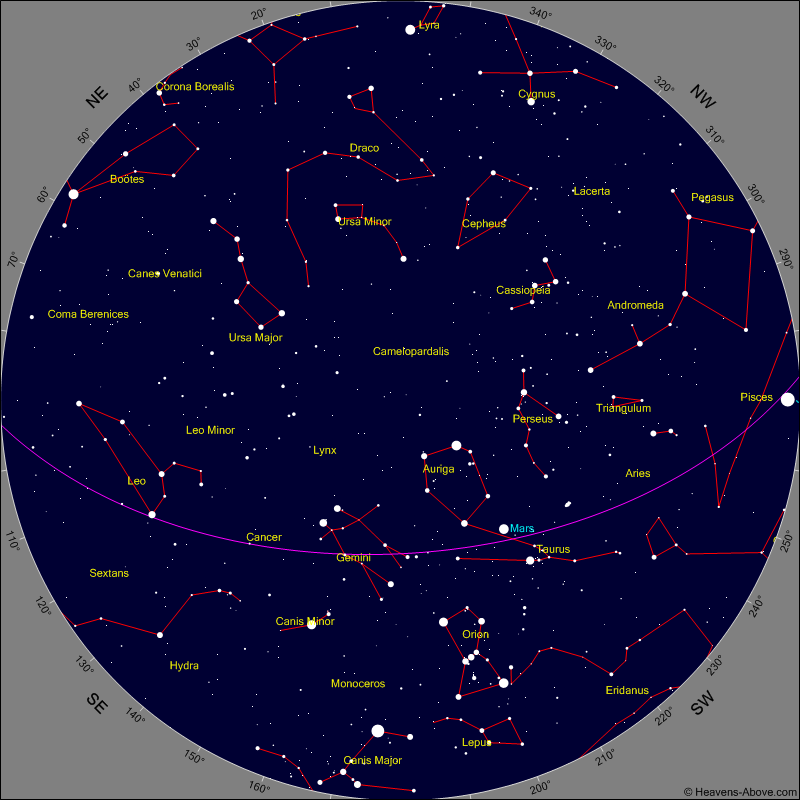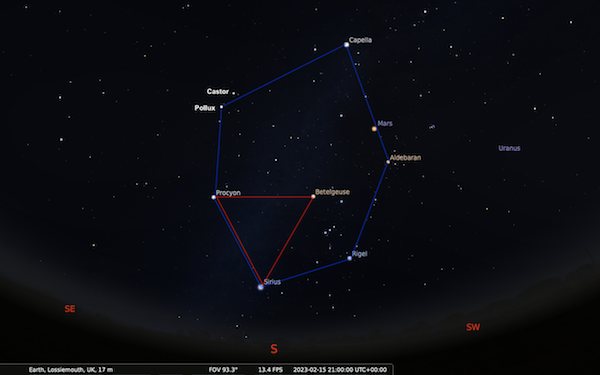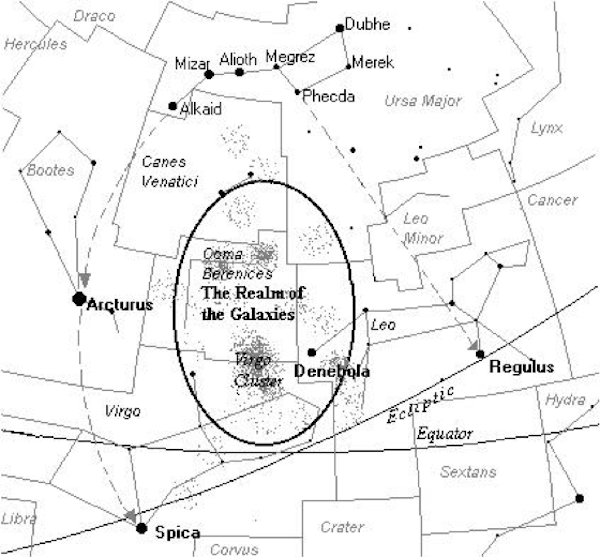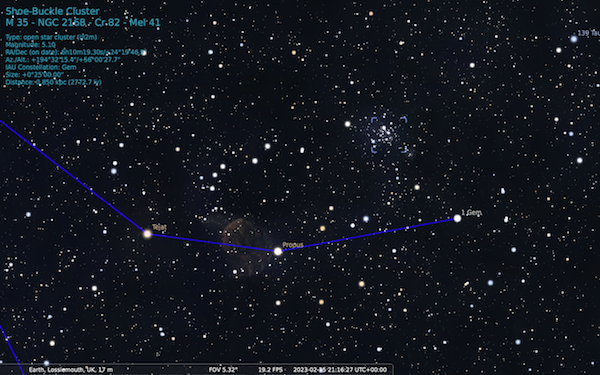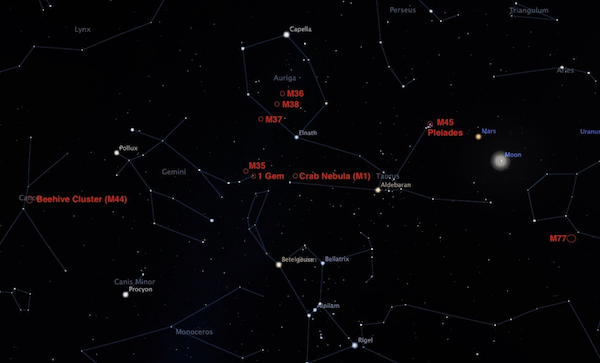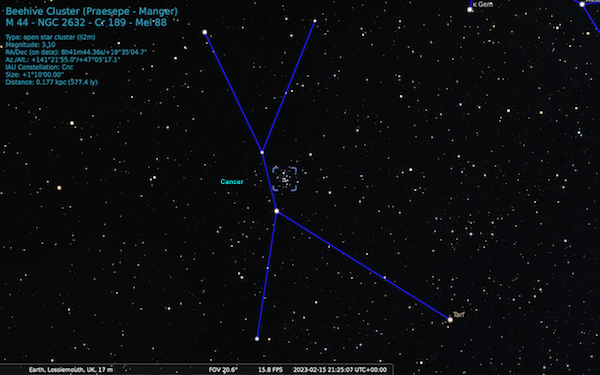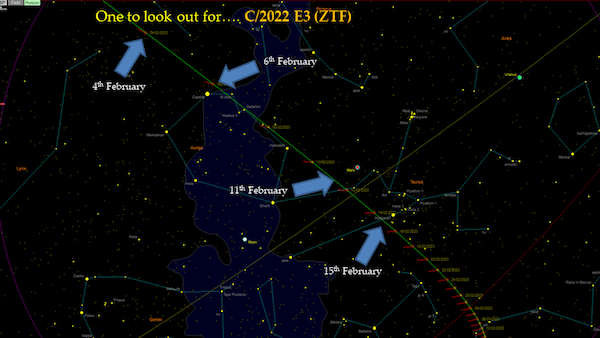Moray Sky at Night February 2023

Moon Phases February 2023
Full Moon 05th,
Last quarter 13th,
New moon 20th,
First quarter 27th Feb ’23.
Image courtesy of https://moonphases.co.uk
The Planets
Mercury Invisible in the twilight.
Venus Is bright (mag. -3.9); will become visible in the evening sky towards the end of the month.
Mars In Taurus, fading from mag -0.3 to 0.4 over the month.
Jupiter In Pisces average mag. -2.1
Saturn In Capricornus at Mag 0.8.
Uranus Much closer to the sun and will be lost in the twilight.
Neptune In Pisces at mag. +7.9 to 8.0
MORAY’S NIGHT SKY – 15th February 2023 @21:00 hrs GMT
Thanks to Chris Peat at Heavens-above.com for use of the star map
Meteor Showers
There are no major meteor showers in February or March 2023.
February Overview
A different take on the Big G of the winter sky I talked about last month, is the Winter Circle (or Winter Hexagon). It’s not one of the 88 recognized constellations but is an asterism, a pattern of stars that’s fairly easy to recognize. The image below can’t adequately convey the Winter Circle’s enormous size! It dwarfs the constellation Orion the Hunter, which is a rather large constellation, occupying the southwestern part of the Winter Circle pattern.
The Winter Circle in blue. It contains another asterism in red, The Winter Triangle.
The constellation of Orion sits within the Winter Circle, containing Betelgeuse and Rigel.
These will be viewable for months to come.
To locate the Winter Circle at nightfall and early evening, look to the south-east for the three stars which make up Orion’s belt. Draw a line downward through Orion’s Belt to find Sirius, the brightest star in the night sky (mag -1.4). This star marks the bottom (the southern tip) of the Winter Circle, as seen from our perspective.
By the way, during these next few nights, the waxing gibbous moon shows you where the sun resides in front of the backdrop stars in June. So enjoy the Winter Circle. And contemplate the sun being in this part of the sky when summer returns to the Northern Hemisphere!
Other than Orion, the most prominent constellation this month is Gemini, with its two lines of stars running south-west towards Orion. Some of us can never remember which is which of the two stars Castor and Pollux. The fainter star (mag. 1.9) Castor is closest to the North Celestial Pole. Pollux is the brighter of the two (Mag. 1.2) but furthest from the Pole. Castor is remarkable as it is actually a multiple system, consisting of no less than six individual stars.
Sirius, mentioned previously, sits in the constellation of Canis Major, the whole of which is now clear of the southern horizon. It forms an equilateral triangle (The Winter Triangle) with Betelgeuse in Orion and Procyon in Canis Minor. Between Canis Minor and Canis Major is the faint constellation Monoceros, which actually straddles the Milky Way, which, although faint, has many clusters in this area.
Directly east of Procyon is the highly distinctive asterism of six stars that form the ‘head’ of Hydra, the largest of the 88 constellations, which trails such a long way that it will be mid-March before the whole constellation is visible.
Rising in the east is Leo (The Lion) in the area known as the realm of the galaxies. The realm of the Galaxies covers the region between the Leo, Coma Berenices, Virgo and Canes Venatici. Here lies one of the richest regions of galaxies visible to amateur telescopes.
Looking north the bright star Vega in Lyra skirts the horizon along with Cygnus these two constellations reach their lowest point in the sky.
Well placed overhead is the constellations of Auriga with its three open star clusters (OC) of M36, M37, M38, M35 and Double star 1-Gemini.
Below Auriga is Taurus (the bull) dominated by the bright star Aldebaran which marks the eye of the bull in the open V shaped cluster of The Hyades. Above the star Zeta Tauri which marks the tip of the bull’s lower horn is where you can find one of the best examples of a supernova remnants in the sky, M1 The Crab Nebula.
West of The Hyades is the superb (OC) The Pleiades a wonderful sight in binoculars of any size. To the east of Gemini is Cancer, a difficult constellation to make out as all the stars in it are relatively dim. It is actually easier to find the (OC) M44 The Beehive Cluster with in it than to find the constellation itself.
February’s Object Challenge
This month’s challenge has to be Comet C/2022 E3 (ZTF) – See the information in this month’s Comet Section.
Comets
C/2022 E3 (ZTF) is now a circumpolar object.
It lies in Camelopardalis when closest to Earth on 02 Feb ‘23, at only 0.29au or 27 million miles (44 million kilometres), then moves close to Capella on 5 Feb ‘23. It then moves through Auriga and on through Taurus during February.
Have a look at website www.in-the-sky.org for up-to-date information.
The green line shows the path of the comet. The red increments on the line are 2 days apart.
ISS
The ISS is a evening object from 19th January until 02 Feb ‘23, after which it won’t be visible for us here.
Then from the 18th Feb it becomes visible in the morning sky until the 8th of March ‘23.
For more info go to https://www.heavens-above.com/PassSummary.aspx?satid=25544 and if you make a free account there and enter your location it gives you a precise timing and starmaps.
For astronomy information have a look at: www.in-the-sky.org
Clear skies!
Mick

